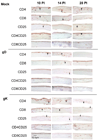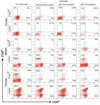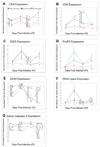Exacerbation of corneal scarring in HSV-1 gK-immunized mice correlates with elevation of CD8+CD25+ T cells in corneas of ocularly infected mice
- PMID: 20079918
- PMCID: PMC2830294
- DOI: 10.1016/j.virol.2009.12.011
Exacerbation of corneal scarring in HSV-1 gK-immunized mice correlates with elevation of CD8+CD25+ T cells in corneas of ocularly infected mice
Abstract
We have shown previously that exacerbation of corneal scarring (CS) in HSV-1 glycoprotein K (gK) immunized mice was associated with CD8+ T cells. In this study, we investigated the type and the nature of the immune responses that are involved in the exacerbation of CS in gK-immunized animals. BALB/c mice were vaccinated with baculovirus expressed gK, gD, or mock-immunized. Twenty-one days after the third immunization, mice were ocularly infected with 2 x 10(5) PFU/eye of virulent HSV-1 strain McKrae. Infiltration of the cornea by CD4+, CD8+, CD25+, CD4+CD25+, CD8+CD25+, CD19+, CD40+, CD40L+, CD62L+, CD95+, B7-1+, B7-2+, MHC-I+, and MHC-II+ cells was monitored by immunohistochemistry, qRT-PCR and FACS at various times post-infection (PI). This study demonstrated for the first time that the presence of CD8+CD25+ T cells in the cornea is correlated with exacerbation of CS in the gK-immunized group.
Copyright 2009 Elsevier Inc. All rights reserved.
Figures








Similar articles
-
Immunization with different viral antigens alters the pattern of T cell exhaustion and latency in herpes simplex virus type 1-infected mice.J Virol. 2010 Dec;84(23):12315-24. doi: 10.1128/JVI.01600-10. Epub 2010 Sep 22. J Virol. 2010. PMID: 20861248 Free PMC article.
-
Involvement of CD8+ T-cells in exacerbation of corneal scarring in mice.Curr Eye Res. 2004 Aug-Sep;29(2-3):145-51. doi: 10.1080/02713680490504632. Curr Eye Res. 2004. PMID: 15512961
-
The role of a glycoprotein K (gK) CD8+ T-cell epitope of herpes simplex virus on virus replication and pathogenicity.Invest Ophthalmol Vis Sci. 2009 Jun;50(6):2903-12. doi: 10.1167/iovs.08-2957. Epub 2009 Jan 24. Invest Ophthalmol Vis Sci. 2009. PMID: 19168902
-
Role of Herpes Simplex Virus Type 1 (HSV-1) Glycoprotein K (gK) Pathogenic CD8+ T Cells in Exacerbation of Eye Disease.Front Immunol. 2018 Dec 7;9:2895. doi: 10.3389/fimmu.2018.02895. eCollection 2018. Front Immunol. 2018. PMID: 30581441 Free PMC article. Review.
-
Overexpression of herpes simplex virus glycoprotein K (gK) alters expression of HSV receptors in ocularly-infected mice.Invest Ophthalmol Vis Sci. 2014 Apr 15;55(4):2442-51. doi: 10.1167/iovs.14-14013. Invest Ophthalmol Vis Sci. 2014. PMID: 24667863 Free PMC article.
Cited by
-
CD8+ T cell-induced expression of tissue inhibitor of metalloproteinses-1 exacerbated osteoarthritis.Int J Mol Sci. 2013 Oct 8;14(10):19951-70. doi: 10.3390/ijms141019951. Int J Mol Sci. 2013. PMID: 24108368 Free PMC article.
-
Murine Corneal Inflammation and Nerve Damage After Infection With HSV-1 Are Promoted by HVEM and Ameliorated by Immune-Modifying Nanoparticle Therapy.Invest Ophthalmol Vis Sci. 2017 Jan 1;58(1):282-291. doi: 10.1167/iovs.16-20668. Invest Ophthalmol Vis Sci. 2017. PMID: 28114589 Free PMC article.
-
Adaptive and innate transforming growth factor beta signaling impact herpes simplex virus 1 latency and reactivation.J Virol. 2011 Nov;85(21):11448-56. doi: 10.1128/JVI.00678-11. Epub 2011 Aug 31. J Virol. 2011. PMID: 21880769 Free PMC article.
-
Mutations within the pathogenic region of herpes simplex virus 1 gK signal sequences alter cell surface expression and neurovirulence.J Virol. 2015 Mar;89(5):2530-42. doi: 10.1128/JVI.03506-14. Epub 2014 Dec 10. J Virol. 2015. PMID: 25505072 Free PMC article.
-
Immunization with different viral antigens alters the pattern of T cell exhaustion and latency in herpes simplex virus type 1-infected mice.J Virol. 2010 Dec;84(23):12315-24. doi: 10.1128/JVI.01600-10. Epub 2010 Sep 22. J Virol. 2010. PMID: 20861248 Free PMC article.
References
-
- Arbones ML, Ord DC, Ley K, Ratech H, Maynard-Curry C, Otten G, Capon DJ, Tedder TF. Lymphocyte homing and leukocyte rolling and migration are impaired in L-selectin-deficient mice. Immunity. 1994;1(4):247–260. - PubMed
-
- Bagenstose LM, Agarwal RK, Silver PB, Harlan DM, Hoffmann SC, Kampen RL, Chan CC, Caspi RR. Disruption of CD40/CD40-ligand interactions in a retinal autoimmunity model results in protection without tolerance. J Immunol. 2005;175(1):124–130. - PubMed
-
- Banerjee K, Deshpande S, Zheng M, Kumaraguru U, Schoenberger SP, Rouse BT. Herpetic stromal keratitis in the absence of viral antigen recognition. Cell Immunol. 2002;219(2):108–118. - PubMed
-
- Barron BA, Gee L, Hauck WW, Kurinij N, Dawson CR, Jones DB, Wilhelmus KR, Kaufman HE, Sugar J, Hyndiuk RA, et al. Herpetic Eye Disease Study. A controlled trial of oral acyclovir for herpes simplex stromal keratitis. Ophthalmology. 1994;101(12):1871–1882. - PubMed
-
- Brandt CR. The role of viral and host genes in corneal infection with herpes simplex virus type 1. Exp Eye Res. 2005;80(5):607–621. - PubMed
Publication types
MeSH terms
Substances
Grants and funding
LinkOut - more resources
Full Text Sources
Other Literature Sources
Medical
Research Materials
Miscellaneous

